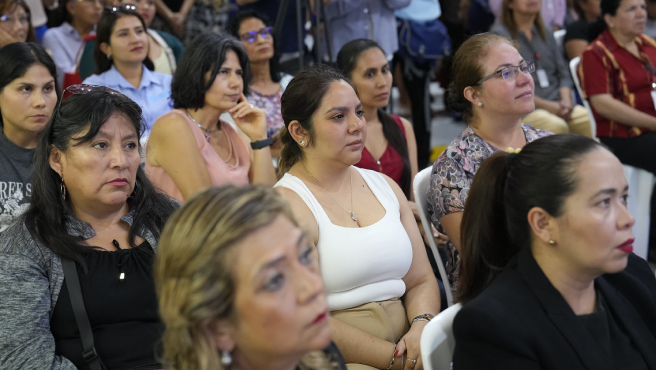This March 8th more than 17 million 300 thousand women celebrates its day in Peru
Nota de prensa
7 de March de 2025 - 9:47 a. m.
On the occasion of the International Women's Day, date in which we recognize and value her role in the society and constant search of equal right and opportunities, the National Institute of Statistics and Informatics (INEI) informed that according to the projections of the population as of 2025, women in Peru reached 17 million 325 thousand 148 and represented 50.4 % of the total population (34 million 350 thousand 244).
According to age groups, 23.1 % of the total of women are under 15 years old, 51.5 % are between 15 to 49 years old; it means they are in child-bearing age; 10.5% are between 50 to 59 years old and 14.9% are older adult women (60 years old and older).
It is important to point out that for 2025, the women life expectancy at birth is of 80.1 years old, higher than that of men (74.9 years old).
52.6 % of older adult population are women
As of 2025, the female older adult population (60 years of age and older) reached 2 million 578 thousand 331 and represent the 52.6% of the older adult population of the country. In addition, 16.9% of these women are octogenarian (80 years old and older).
Women have in average 1.8 children
According to Demographic and Family Health Survey (ENDES) 2023, women of child-bearing age at national level, have in average 1.8 children. By its place of residence is observed that in urban area the number of children per women is 1.7; meanwhile, in the rural area is of 2.7 children.
90.0% of women have health insurance
The National Household Survey (ENAHO) shows that 90.0% of women at national level have health insurance. By its place of residence, it is observed that the mentioned proportion covers 89.0% in the urban area and in the rural area covers 94.4%.
42 out of 100 women have high-school education level
According to education level reached of women of 15 years old and older, 5.1% have early education or with no- education level, 20.7% have primary education level, 41.6% have secondary education level, 15.5% have non-university superior education level and 17.0% have university superior education level.
Increased household headed by women
At national level, households headed by women reached 37.7% as of 2023, result higher in 11.2 percentage points compared to the year 2013 (26.5%). By its place of residence is noted that in the urban area, the households headed by women represented the 39.9% and in the rural area, the households headed by women represented the 29.3%.
62.0% of women participate in the economic activity
The Permanent Survey of National Employment (EPEN) revealed that in 2023, the proportion of women in working age that actively participates in the labor market, whether working or seeking employment, represented the 62.0%.
In the country 44 out of every 100 persons that work are women
According to EPEN 2023, from the total of persons of 14 years old and older that have employment, 44.4% are women and 55.6% are men. By age groups, it is appreciated a greater participation of adult women of 25 to 44 years old with 47.3% followed by those of 45 years of age and older that represented the 37.3% and the young women of under 25 years old with 15.4%.
75 out of 100 women work in micro and small companies
According to the size of company where women work, 74.6% of women that work they do it in companies of 1 to 10 employees, 19.5% in economic units of 51 to more employees and 5.9% in establishments of 11 to 50 employees.
45 out of 100 women that work are dependents
By occupation category, 45.3% of women with employment are in condition of dependents, 41.5% independents and 13.2% are unpaid family workers.
75.4% of women use Internet
As of 2023, the ENAHO showed that at national level, 75.4% of women of 6 years old and older use the Internet. By residence area, 81.3% of women that live in urban area accessed to this Information and Communication Technology; meanwhile, among the residents of the rural area was of 48.4%.